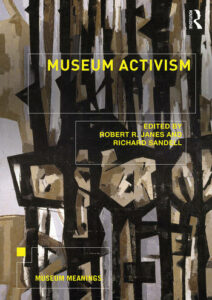Museum Activism, edited by Robert R. Janes and Richard Sandell. London, New York: Routledge, 2019.
REVIEWED BY PIA SCHWAIGER

The anthology Museum Activism gathers contributions from museum actors from all over the world and from a variety of professional groups. The book contributes to the discussion on the changing social, political and cultural significance of museums. The museum is not understood here as an institution whose sole task is to preserve collections and objects. The articles instead consider the museum in interplay with concepts such as identity, community, ethics, politics and place, and thus constitute a “knowledge-based, social” (Sandell and Janes, xviii) institution.
For some years now, there has been a debate in the wider museum community about whether museums ought to take a part in engendering social change. At issue is whether activist engagement is seen as inappropriately political and a breach of the the profession’s core ethical values. Only a few years ago, skepticism was the predominant response to the engagement of museums, galleries and heritage organizations in activist practice. The anthology attempts to respond to this situation by challenging the notion of the supposed neutrality of the museum (see in particular Bailey’s contribution, 293-303). It also seizes on the ethical turn evident in the humanities and contributes to close the research gap in exploring the role of museums as activists.
Museum Activism clearly positions itself within this discourse. Ultimately, the authors see an increasing importance of the activist trend in thought and practice. Activist practice is defined by the editors as “marshalling and directing their [the museum’s] unique resources with explicit intent to act upon inequalities, injustices, and environmental crises” (Sandell and Janes, xxvii). Addressing these issues appears to be part of the essence of a museum. Consequently, the essays promote a non-hierarchical commitment to collective responsibility and the implementation of new modes of thinking and working in order to redefine the contemporary museum. The main argument of the anthology is that the museum should act according to its role “as a social institution and important civic resource” (Janes and Sandell, 2). What this entails is exemplified by 33 articles that combine theoretical and practical approaches, as the authors and editors posit their mutual conditionality as a basic premise.
The anthology consists of three parts. The first part, “Nurturing activism”, brings together case studies that illuminate what is needed to foster these new ways of thinking and working. What structural changes need to take place before an institution can become activist? The contributions address not only international conditions and broader social issues (see for example Vlachou, 47-57), such as decolonization (Wajid and Minott, 25-35) and feminism (Golding, 127-136), but also the museum as an employer (Hollows, 80-90), the education sector (Wood and Cole 36-36) and the communities in which and for which the museum works (Kudlick and Luby, 58-68; Coleman and Moore, 91-103). The second part, “Activism in Practice,” looks at case studies that address challenges in different geopolitical contexts. The contributions were selected according to the goals and values of their initiatives: a so-called progressive activism is emphasized here. For the editors, this means that activism refers to “ideals such as equality and social justice, respect for the natural world, and a concern for our shared futures.” (p. 135). It is about political curating (French, 152-163), networking (McCann, 220-231) or forms of loud and quiet activism by museums (Brekke, 268-277). “Assessing activism”, the last part, is about the impact and challenges of initiatives. The articles here narrate risks and challenges (Coffee, 303-314; Wray, 315-325), but also emphasize the “immorality of inaction” (p. 289) and show how ideals and challenges were utilized and translated into action (Bergevin, 348-358; Kidd, 388-398) in the case studies.
The anthology offers a variety of perspectives: Not only for students of museum studies, but also for professionals in museums, galleries, cultural heritage institutions or the like will find numerous points of reference here. Precisely because activism is based on ethical values and self-reflection and therefore concerns each individual as well as collectives, the contributions provide many suggestions and impulses for thought. This anthology is therefore also recommended to all those who aspire to a career in the broad field of cultural institutions. It functions as a collection of best practice examples. However, the sheer volume of contributions can overwhelm the reader here and there. One wonders whether it would not have been better to do without some contributions and instead implement more strongly the emphasis on critical self-reflection and introspection, which is undoubtedly already emphasized as absolutely necessary in all contributions. It should also be kept in mind that this is not a collection of instructions or templates, but rather a compilation of accounts of activism experiments that are highly specific to the given social, local and temporal conditions, depending on the problem and objective. Thereby it sets activism in and by museums into context (for example given by countries policies as described by Vlachou, 47-57).
The anthology explores and reflects on the museum’s relationship to activism. It considers the inherent power of museums as forces for good and as activists in civil society. In doing so, the authors position themselves clearly and encourage further engagement with the museum community. After all, there is huge potential in the field of museum activism. The book shows many different possibilities and encourages to apply the collected case studies to one’s own values, actions/activism and institutions.
Pia Schwaiger is a third year MA student in the Erasmus Mundus Master program Euroculture. In her exchange semester at IUPUI, she adds to her expertise in European political and cultural studies not only by musing on the lifestyle of Americans in the Midwest but also by taking courses in museum studies and journalism.

